Advanced Diploma of Marketing: BSBMKG603 Marketing Process Project
VerifiedAdded on 2020/10/05
|28
|10935
|256
Project
AI Summary
This project, designed for the BSBMKG603 unit on managing the marketing process, presents a comprehensive approach to strategic marketing management. It involves developing a detailed marketing plan for a fashion retail chain, outlining strategies and actions to achieve marketing objectives. The project further delves into personnel management, including identifying roles and responsibilities for implementing the marketing activities and developing a communication strategy. It also includes practical application through role-plays, such as a coaching session and a counseling interview, providing insights into effective communication and leadership within a marketing team. Finally, the project requires the evaluation of marketing outcomes based on a business scenario, culminating in a written report that assesses marketing performance and suggests areas for improvement, demonstrating a full understanding of the marketing process from planning to evaluation.
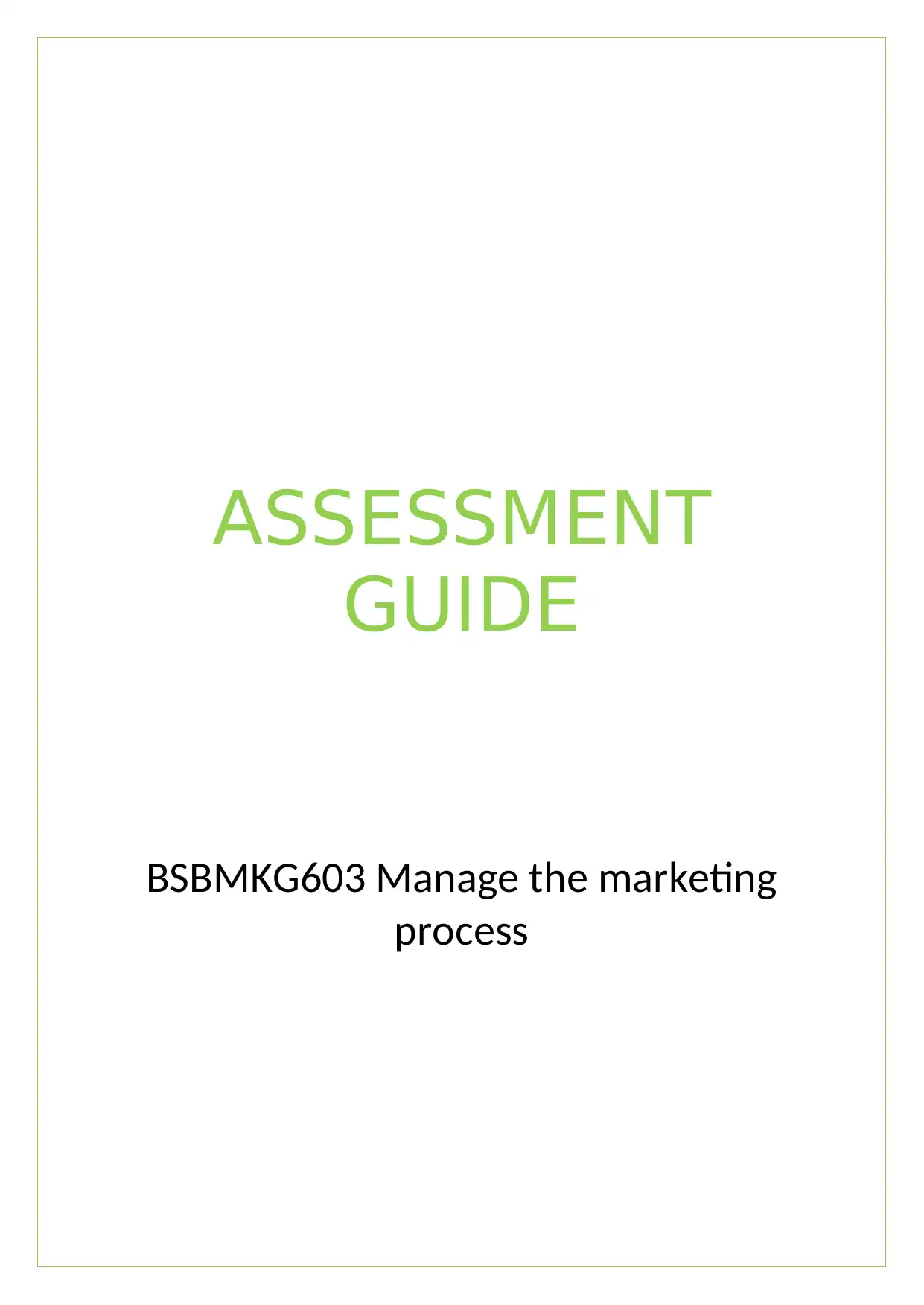
ASSESSMENT
GUIDE
BSBMKG603 Manage the marketing
process
GUIDE
BSBMKG603 Manage the marketing
process
Paraphrase This Document
Need a fresh take? Get an instant paraphrase of this document with our AI Paraphraser
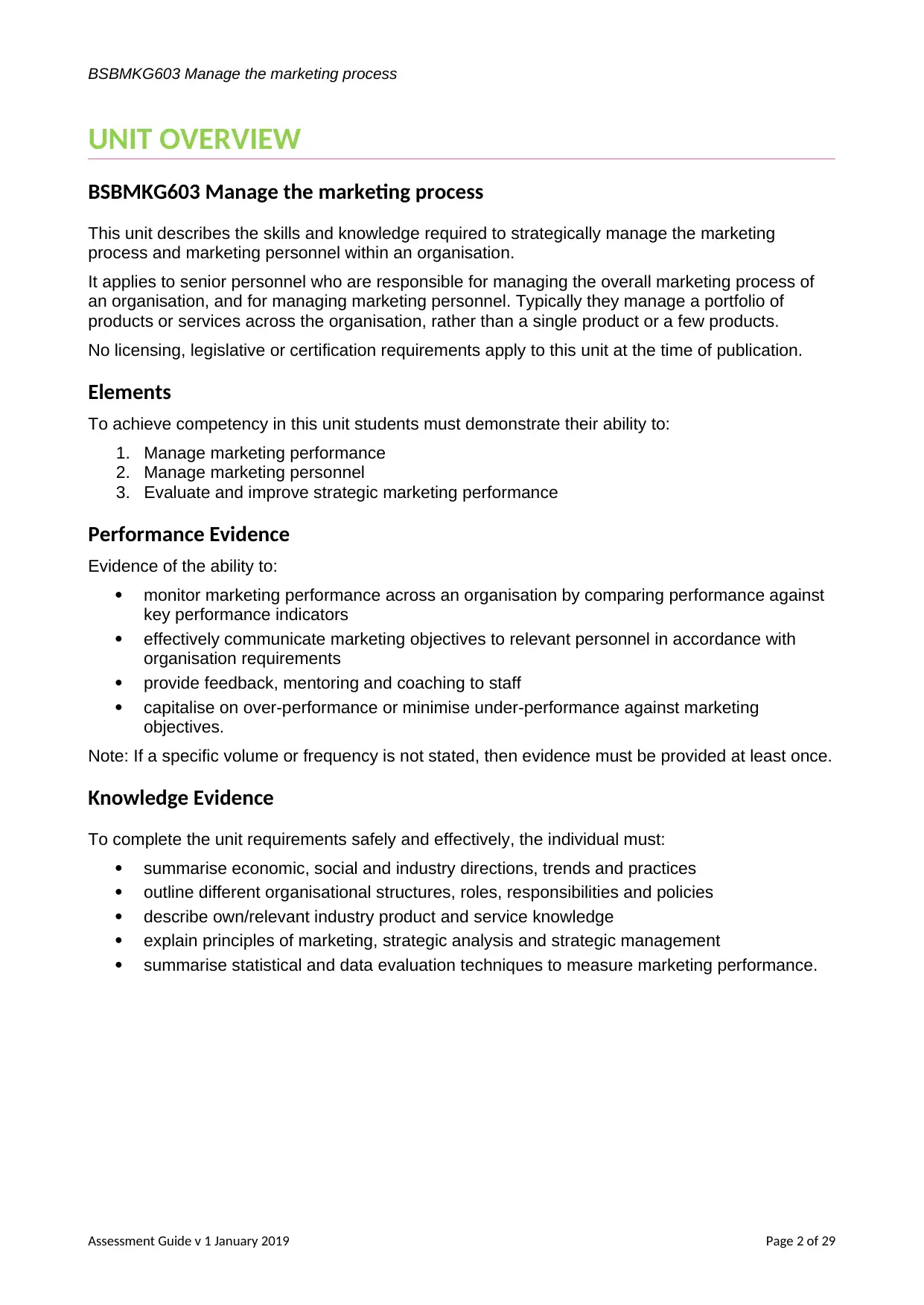
BSBMKG603 Manage the marketing process
UNIT OVERVIEW
BSBMKG603 Manage the marketing process
This unit describes the skills and knowledge required to strategically manage the marketing
process and marketing personnel within an organisation.
It applies to senior personnel who are responsible for managing the overall marketing process of
an organisation, and for managing marketing personnel. Typically they manage a portfolio of
products or services across the organisation, rather than a single product or a few products.
No licensing, legislative or certification requirements apply to this unit at the time of publication.
Elements
To achieve competency in this unit students must demonstrate their ability to:
1. Manage marketing performance
2. Manage marketing personnel
3. Evaluate and improve strategic marketing performance
Performance Evidence
Evidence of the ability to:
monitor marketing performance across an organisation by comparing performance against
key performance indicators
effectively communicate marketing objectives to relevant personnel in accordance with
organisation requirements
provide feedback, mentoring and coaching to staff
capitalise on over-performance or minimise under-performance against marketing
objectives.
Note: If a specific volume or frequency is not stated, then evidence must be provided at least once.
Knowledge Evidence
To complete the unit requirements safely and effectively, the individual must:
summarise economic, social and industry directions, trends and practices
outline different organisational structures, roles, responsibilities and policies
describe own/relevant industry product and service knowledge
explain principles of marketing, strategic analysis and strategic management
summarise statistical and data evaluation techniques to measure marketing performance.
Assessment Guide v 1 January 2019 Page 2 of 29
UNIT OVERVIEW
BSBMKG603 Manage the marketing process
This unit describes the skills and knowledge required to strategically manage the marketing
process and marketing personnel within an organisation.
It applies to senior personnel who are responsible for managing the overall marketing process of
an organisation, and for managing marketing personnel. Typically they manage a portfolio of
products or services across the organisation, rather than a single product or a few products.
No licensing, legislative or certification requirements apply to this unit at the time of publication.
Elements
To achieve competency in this unit students must demonstrate their ability to:
1. Manage marketing performance
2. Manage marketing personnel
3. Evaluate and improve strategic marketing performance
Performance Evidence
Evidence of the ability to:
monitor marketing performance across an organisation by comparing performance against
key performance indicators
effectively communicate marketing objectives to relevant personnel in accordance with
organisation requirements
provide feedback, mentoring and coaching to staff
capitalise on over-performance or minimise under-performance against marketing
objectives.
Note: If a specific volume or frequency is not stated, then evidence must be provided at least once.
Knowledge Evidence
To complete the unit requirements safely and effectively, the individual must:
summarise economic, social and industry directions, trends and practices
outline different organisational structures, roles, responsibilities and policies
describe own/relevant industry product and service knowledge
explain principles of marketing, strategic analysis and strategic management
summarise statistical and data evaluation techniques to measure marketing performance.
Assessment Guide v 1 January 2019 Page 2 of 29
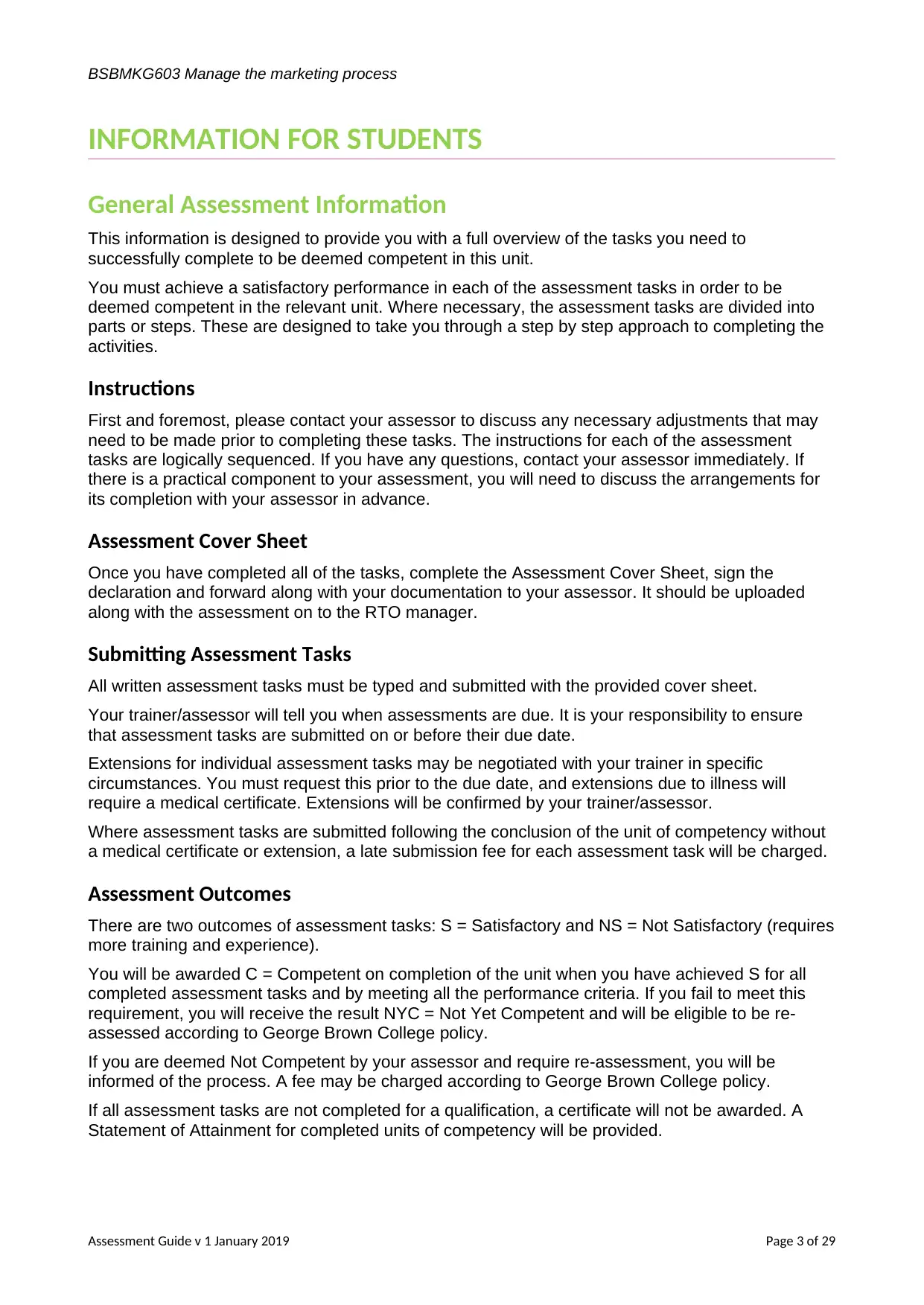
BSBMKG603 Manage the marketing process
INFORMATION FOR STUDENTS
General Assessment Information
This information is designed to provide you with a full overview of the tasks you need to
successfully complete to be deemed competent in this unit.
You must achieve a satisfactory performance in each of the assessment tasks in order to be
deemed competent in the relevant unit. Where necessary, the assessment tasks are divided into
parts or steps. These are designed to take you through a step by step approach to completing the
activities.
Instructions
First and foremost, please contact your assessor to discuss any necessary adjustments that may
need to be made prior to completing these tasks. The instructions for each of the assessment
tasks are logically sequenced. If you have any questions, contact your assessor immediately. If
there is a practical component to your assessment, you will need to discuss the arrangements for
its completion with your assessor in advance.
Assessment Cover Sheet
Once you have completed all of the tasks, complete the Assessment Cover Sheet, sign the
declaration and forward along with your documentation to your assessor. It should be uploaded
along with the assessment on to the RTO manager.
Submitting Assessment Tasks
All written assessment tasks must be typed and submitted with the provided cover sheet.
Your trainer/assessor will tell you when assessments are due. It is your responsibility to ensure
that assessment tasks are submitted on or before their due date.
Extensions for individual assessment tasks may be negotiated with your trainer in specific
circumstances. You must request this prior to the due date, and extensions due to illness will
require a medical certificate. Extensions will be confirmed by your trainer/assessor.
Where assessment tasks are submitted following the conclusion of the unit of competency without
a medical certificate or extension, a late submission fee for each assessment task will be charged.
Assessment Outcomes
There are two outcomes of assessment tasks: S = Satisfactory and NS = Not Satisfactory (requires
more training and experience).
You will be awarded C = Competent on completion of the unit when you have achieved S for all
completed assessment tasks and by meeting all the performance criteria. If you fail to meet this
requirement, you will receive the result NYC = Not Yet Competent and will be eligible to be re-
assessed according to George Brown College policy.
If you are deemed Not Competent by your assessor and require re-assessment, you will be
informed of the process. A fee may be charged according to George Brown College policy.
If all assessment tasks are not completed for a qualification, a certificate will not be awarded. A
Statement of Attainment for completed units of competency will be provided.
Assessment Guide v 1 January 2019 Page 3 of 29
INFORMATION FOR STUDENTS
General Assessment Information
This information is designed to provide you with a full overview of the tasks you need to
successfully complete to be deemed competent in this unit.
You must achieve a satisfactory performance in each of the assessment tasks in order to be
deemed competent in the relevant unit. Where necessary, the assessment tasks are divided into
parts or steps. These are designed to take you through a step by step approach to completing the
activities.
Instructions
First and foremost, please contact your assessor to discuss any necessary adjustments that may
need to be made prior to completing these tasks. The instructions for each of the assessment
tasks are logically sequenced. If you have any questions, contact your assessor immediately. If
there is a practical component to your assessment, you will need to discuss the arrangements for
its completion with your assessor in advance.
Assessment Cover Sheet
Once you have completed all of the tasks, complete the Assessment Cover Sheet, sign the
declaration and forward along with your documentation to your assessor. It should be uploaded
along with the assessment on to the RTO manager.
Submitting Assessment Tasks
All written assessment tasks must be typed and submitted with the provided cover sheet.
Your trainer/assessor will tell you when assessments are due. It is your responsibility to ensure
that assessment tasks are submitted on or before their due date.
Extensions for individual assessment tasks may be negotiated with your trainer in specific
circumstances. You must request this prior to the due date, and extensions due to illness will
require a medical certificate. Extensions will be confirmed by your trainer/assessor.
Where assessment tasks are submitted following the conclusion of the unit of competency without
a medical certificate or extension, a late submission fee for each assessment task will be charged.
Assessment Outcomes
There are two outcomes of assessment tasks: S = Satisfactory and NS = Not Satisfactory (requires
more training and experience).
You will be awarded C = Competent on completion of the unit when you have achieved S for all
completed assessment tasks and by meeting all the performance criteria. If you fail to meet this
requirement, you will receive the result NYC = Not Yet Competent and will be eligible to be re-
assessed according to George Brown College policy.
If you are deemed Not Competent by your assessor and require re-assessment, you will be
informed of the process. A fee may be charged according to George Brown College policy.
If all assessment tasks are not completed for a qualification, a certificate will not be awarded. A
Statement of Attainment for completed units of competency will be provided.
Assessment Guide v 1 January 2019 Page 3 of 29
⊘ This is a preview!⊘
Do you want full access?
Subscribe today to unlock all pages.

Trusted by 1+ million students worldwide
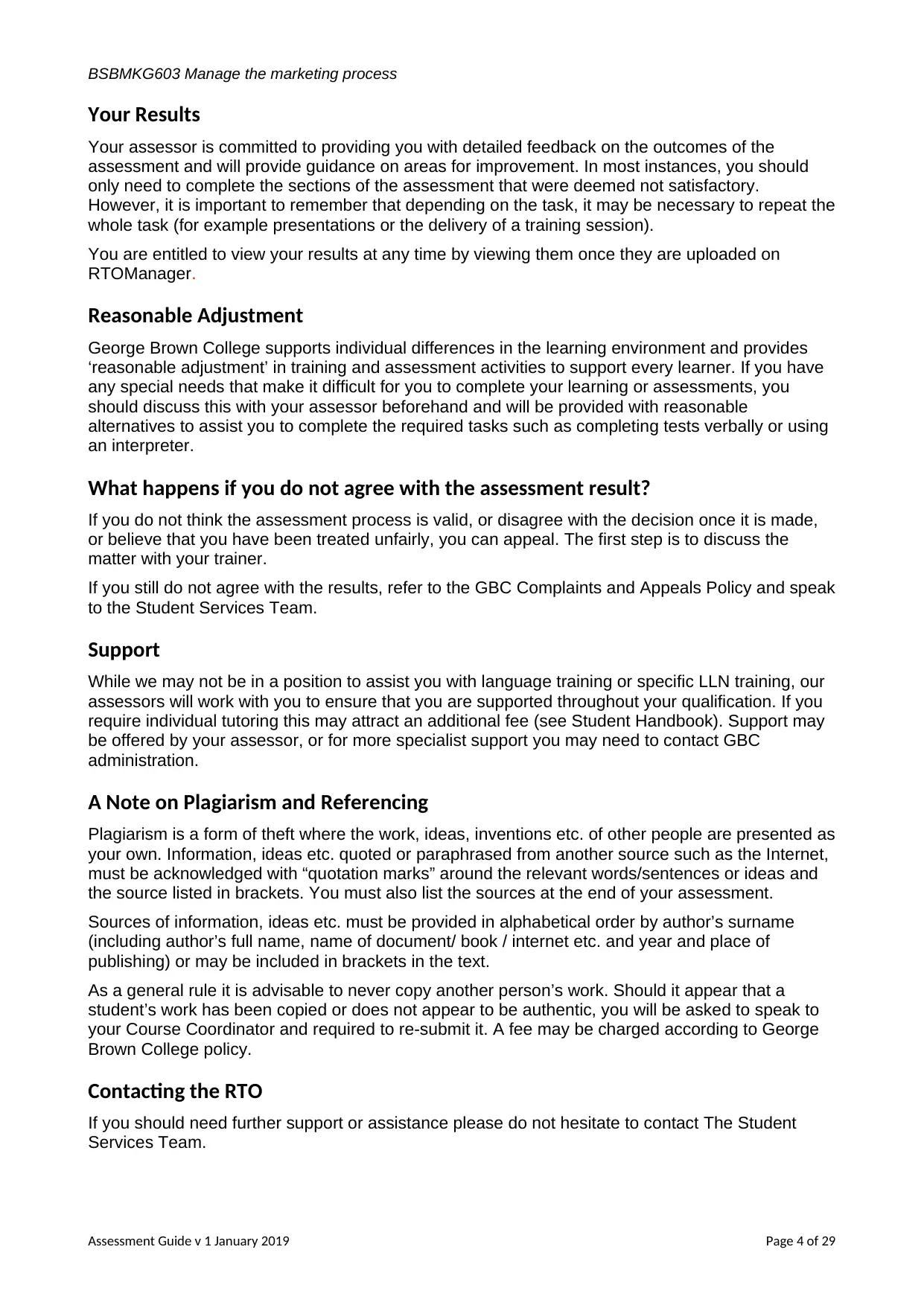
BSBMKG603 Manage the marketing process
Your Results
Your assessor is committed to providing you with detailed feedback on the outcomes of the
assessment and will provide guidance on areas for improvement. In most instances, you should
only need to complete the sections of the assessment that were deemed not satisfactory.
However, it is important to remember that depending on the task, it may be necessary to repeat the
whole task (for example presentations or the delivery of a training session).
You are entitled to view your results at any time by viewing them once they are uploaded on
RTOManager.
Reasonable Adjustment
George Brown College supports individual differences in the learning environment and provides
‘reasonable adjustment’ in training and assessment activities to support every learner. If you have
any special needs that make it difficult for you to complete your learning or assessments, you
should discuss this with your assessor beforehand and will be provided with reasonable
alternatives to assist you to complete the required tasks such as completing tests verbally or using
an interpreter.
What happens if you do not agree with the assessment result?
If you do not think the assessment process is valid, or disagree with the decision once it is made,
or believe that you have been treated unfairly, you can appeal. The first step is to discuss the
matter with your trainer.
If you still do not agree with the results, refer to the GBC Complaints and Appeals Policy and speak
to the Student Services Team.
Support
While we may not be in a position to assist you with language training or specific LLN training, our
assessors will work with you to ensure that you are supported throughout your qualification. If you
require individual tutoring this may attract an additional fee (see Student Handbook). Support may
be offered by your assessor, or for more specialist support you may need to contact GBC
administration.
A Note on Plagiarism and Referencing
Plagiarism is a form of theft where the work, ideas, inventions etc. of other people are presented as
your own. Information, ideas etc. quoted or paraphrased from another source such as the Internet,
must be acknowledged with “quotation marks” around the relevant words/sentences or ideas and
the source listed in brackets. You must also list the sources at the end of your assessment.
Sources of information, ideas etc. must be provided in alphabetical order by author’s surname
(including author’s full name, name of document/ book / internet etc. and year and place of
publishing) or may be included in brackets in the text.
As a general rule it is advisable to never copy another person’s work. Should it appear that a
student’s work has been copied or does not appear to be authentic, you will be asked to speak to
your Course Coordinator and required to re-submit it. A fee may be charged according to George
Brown College policy.
Contacting the RTO
If you should need further support or assistance please do not hesitate to contact The Student
Services Team.
Assessment Guide v 1 January 2019 Page 4 of 29
Your Results
Your assessor is committed to providing you with detailed feedback on the outcomes of the
assessment and will provide guidance on areas for improvement. In most instances, you should
only need to complete the sections of the assessment that were deemed not satisfactory.
However, it is important to remember that depending on the task, it may be necessary to repeat the
whole task (for example presentations or the delivery of a training session).
You are entitled to view your results at any time by viewing them once they are uploaded on
RTOManager.
Reasonable Adjustment
George Brown College supports individual differences in the learning environment and provides
‘reasonable adjustment’ in training and assessment activities to support every learner. If you have
any special needs that make it difficult for you to complete your learning or assessments, you
should discuss this with your assessor beforehand and will be provided with reasonable
alternatives to assist you to complete the required tasks such as completing tests verbally or using
an interpreter.
What happens if you do not agree with the assessment result?
If you do not think the assessment process is valid, or disagree with the decision once it is made,
or believe that you have been treated unfairly, you can appeal. The first step is to discuss the
matter with your trainer.
If you still do not agree with the results, refer to the GBC Complaints and Appeals Policy and speak
to the Student Services Team.
Support
While we may not be in a position to assist you with language training or specific LLN training, our
assessors will work with you to ensure that you are supported throughout your qualification. If you
require individual tutoring this may attract an additional fee (see Student Handbook). Support may
be offered by your assessor, or for more specialist support you may need to contact GBC
administration.
A Note on Plagiarism and Referencing
Plagiarism is a form of theft where the work, ideas, inventions etc. of other people are presented as
your own. Information, ideas etc. quoted or paraphrased from another source such as the Internet,
must be acknowledged with “quotation marks” around the relevant words/sentences or ideas and
the source listed in brackets. You must also list the sources at the end of your assessment.
Sources of information, ideas etc. must be provided in alphabetical order by author’s surname
(including author’s full name, name of document/ book / internet etc. and year and place of
publishing) or may be included in brackets in the text.
As a general rule it is advisable to never copy another person’s work. Should it appear that a
student’s work has been copied or does not appear to be authentic, you will be asked to speak to
your Course Coordinator and required to re-submit it. A fee may be charged according to George
Brown College policy.
Contacting the RTO
If you should need further support or assistance please do not hesitate to contact The Student
Services Team.
Assessment Guide v 1 January 2019 Page 4 of 29
Paraphrase This Document
Need a fresh take? Get an instant paraphrase of this document with our AI Paraphraser
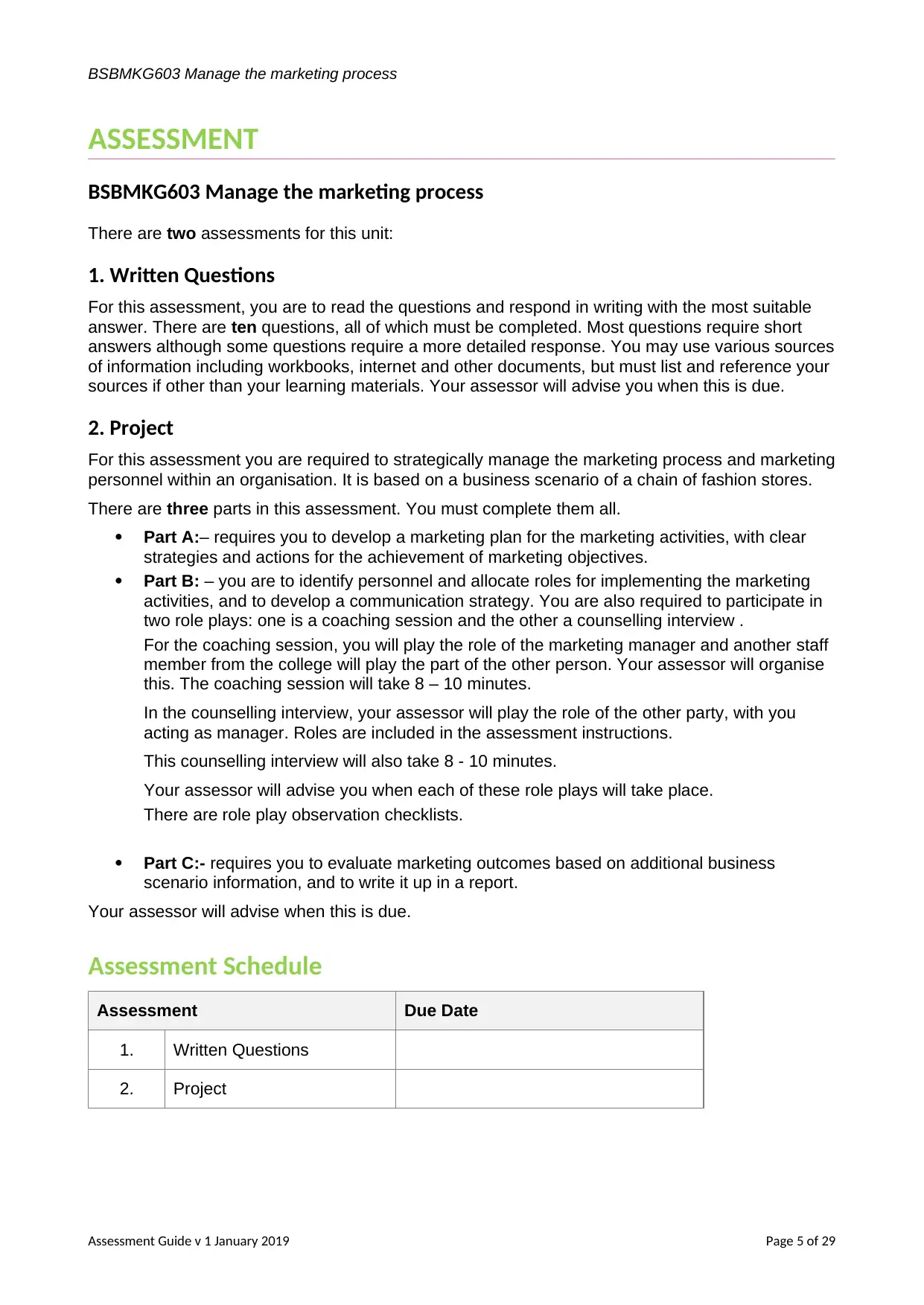
BSBMKG603 Manage the marketing process
ASSESSMENT
BSBMKG603 Manage the marketing process
There are two assessments for this unit:
1. Written Questions
For this assessment, you are to read the questions and respond in writing with the most suitable
answer. There are ten questions, all of which must be completed. Most questions require short
answers although some questions require a more detailed response. You may use various sources
of information including workbooks, internet and other documents, but must list and reference your
sources if other than your learning materials. Your assessor will advise you when this is due.
2. Project
For this assessment you are required to strategically manage the marketing process and marketing
personnel within an organisation. It is based on a business scenario of a chain of fashion stores.
There are three parts in this assessment. You must complete them all.
Part A:– requires you to develop a marketing plan for the marketing activities, with clear
strategies and actions for the achievement of marketing objectives.
Part B: – you are to identify personnel and allocate roles for implementing the marketing
activities, and to develop a communication strategy. You are also required to participate in
two role plays: one is a coaching session and the other a counselling interview .
For the coaching session, you will play the role of the marketing manager and another staff
member from the college will play the part of the other person. Your assessor will organise
this. The coaching session will take 8 – 10 minutes.
In the counselling interview, your assessor will play the role of the other party, with you
acting as manager. Roles are included in the assessment instructions.
This counselling interview will also take 8 - 10 minutes.
Your assessor will advise you when each of these role plays will take place.
There are role play observation checklists.
Part C:- requires you to evaluate marketing outcomes based on additional business
scenario information, and to write it up in a report.
Your assessor will advise when this is due.
Assessment Schedule
Assessment Due Date
1. Written Questions
2. Project
Assessment Guide v 1 January 2019 Page 5 of 29
ASSESSMENT
BSBMKG603 Manage the marketing process
There are two assessments for this unit:
1. Written Questions
For this assessment, you are to read the questions and respond in writing with the most suitable
answer. There are ten questions, all of which must be completed. Most questions require short
answers although some questions require a more detailed response. You may use various sources
of information including workbooks, internet and other documents, but must list and reference your
sources if other than your learning materials. Your assessor will advise you when this is due.
2. Project
For this assessment you are required to strategically manage the marketing process and marketing
personnel within an organisation. It is based on a business scenario of a chain of fashion stores.
There are three parts in this assessment. You must complete them all.
Part A:– requires you to develop a marketing plan for the marketing activities, with clear
strategies and actions for the achievement of marketing objectives.
Part B: – you are to identify personnel and allocate roles for implementing the marketing
activities, and to develop a communication strategy. You are also required to participate in
two role plays: one is a coaching session and the other a counselling interview .
For the coaching session, you will play the role of the marketing manager and another staff
member from the college will play the part of the other person. Your assessor will organise
this. The coaching session will take 8 – 10 minutes.
In the counselling interview, your assessor will play the role of the other party, with you
acting as manager. Roles are included in the assessment instructions.
This counselling interview will also take 8 - 10 minutes.
Your assessor will advise you when each of these role plays will take place.
There are role play observation checklists.
Part C:- requires you to evaluate marketing outcomes based on additional business
scenario information, and to write it up in a report.
Your assessor will advise when this is due.
Assessment Schedule
Assessment Due Date
1. Written Questions
2. Project
Assessment Guide v 1 January 2019 Page 5 of 29
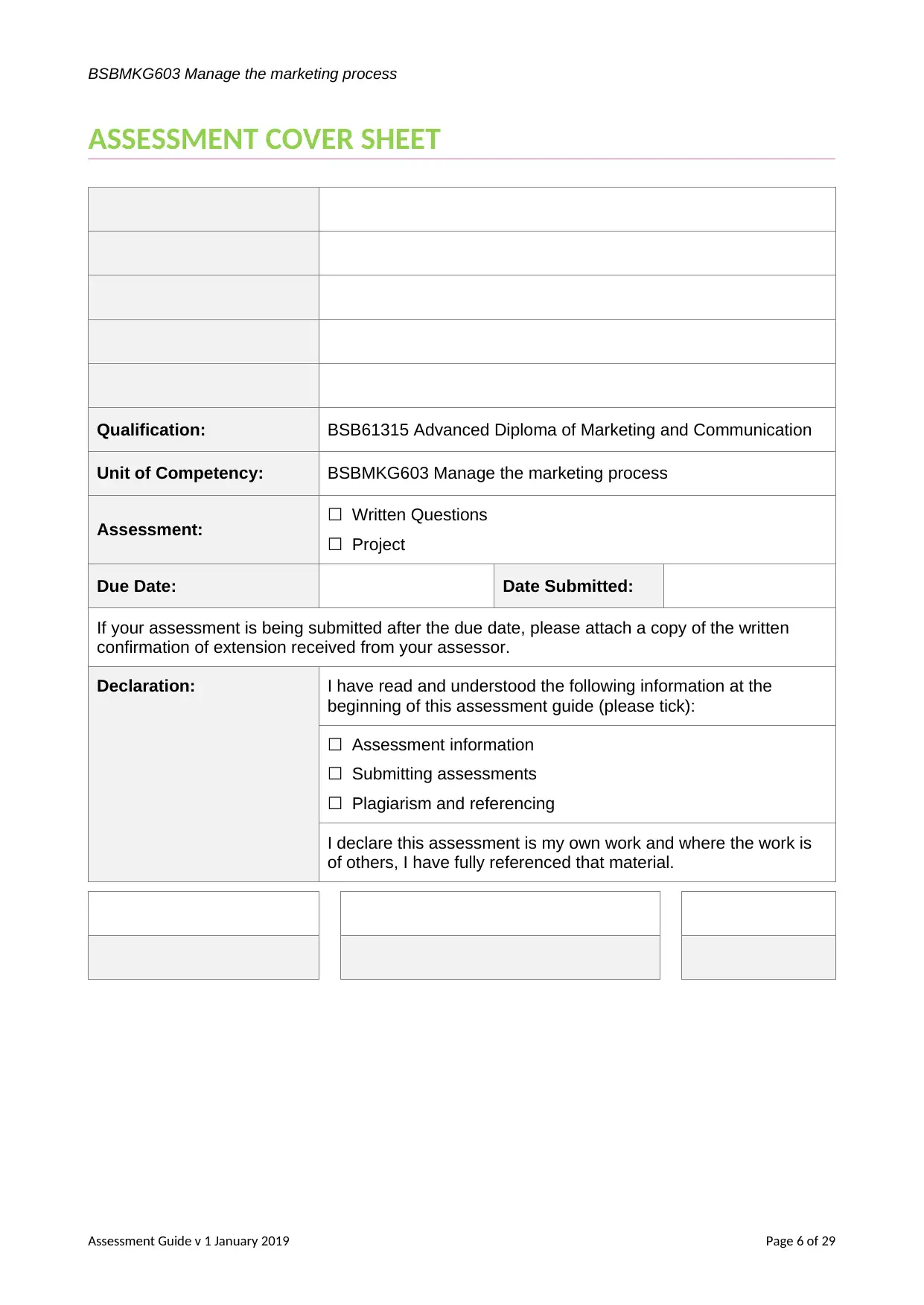
BSBMKG603 Manage the marketing process
ASSESSMENT COVER SHEET
Qualification: BSB61315 Advanced Diploma of Marketing and Communication
Unit of Competency: BSBMKG603 Manage the marketing process
Assessment: ☐ Written Questions
☐ Project
Due Date: Date Submitted:
If your assessment is being submitted after the due date, please attach a copy of the written
confirmation of extension received from your assessor.
Declaration: I have read and understood the following information at the
beginning of this assessment guide (please tick):
☐ Assessment information
☐ Submitting assessments
☐ Plagiarism and referencing
I declare this assessment is my own work and where the work is
of others, I have fully referenced that material.
Assessment Guide v 1 January 2019 Page 6 of 29
ASSESSMENT COVER SHEET
Qualification: BSB61315 Advanced Diploma of Marketing and Communication
Unit of Competency: BSBMKG603 Manage the marketing process
Assessment: ☐ Written Questions
☐ Project
Due Date: Date Submitted:
If your assessment is being submitted after the due date, please attach a copy of the written
confirmation of extension received from your assessor.
Declaration: I have read and understood the following information at the
beginning of this assessment guide (please tick):
☐ Assessment information
☐ Submitting assessments
☐ Plagiarism and referencing
I declare this assessment is my own work and where the work is
of others, I have fully referenced that material.
Assessment Guide v 1 January 2019 Page 6 of 29
⊘ This is a preview!⊘
Do you want full access?
Subscribe today to unlock all pages.

Trusted by 1+ million students worldwide
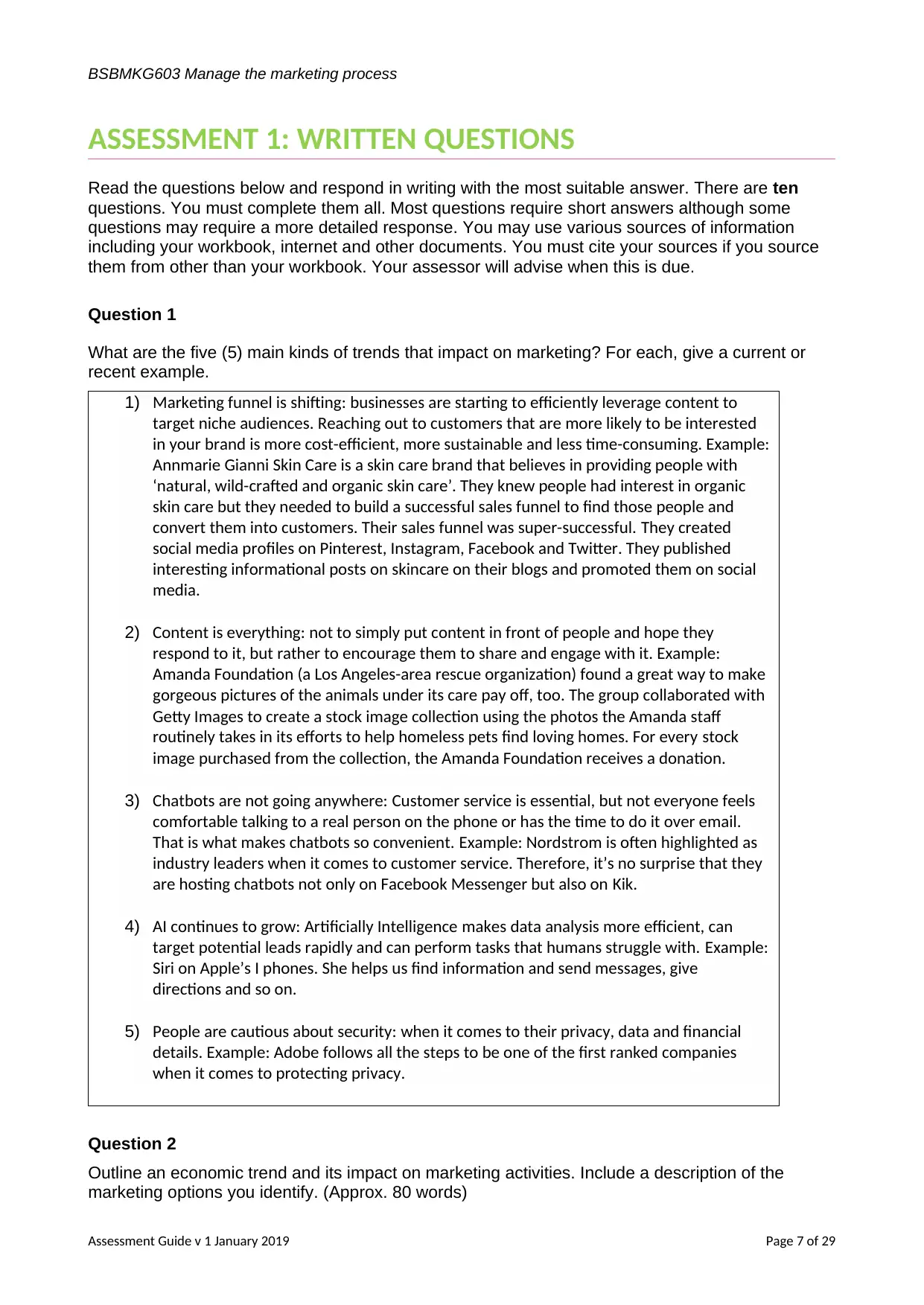
BSBMKG603 Manage the marketing process
ASSESSMENT 1: WRITTEN QUESTIONS
Read the questions below and respond in writing with the most suitable answer. There are ten
questions. You must complete them all. Most questions require short answers although some
questions may require a more detailed response. You may use various sources of information
including your workbook, internet and other documents. You must cite your sources if you source
them from other than your workbook. Your assessor will advise when this is due.
Question 1
What are the five (5) main kinds of trends that impact on marketing? For each, give a current or
recent example.
1) Marketing funnel is shifting: businesses are starting to efficiently leverage content to
target niche audiences. Reaching out to customers that are more likely to be interested
in your brand is more cost-efficient, more sustainable and less time-consuming. Example:
Annmarie Gianni Skin Care is a skin care brand that believes in providing people with
‘natural, wild-crafted and organic skin care’. They knew people had interest in organic
skin care but they needed to build a successful sales funnel to find those people and
convert them into customers. Their sales funnel was super-successful. They created
social media profiles on Pinterest, Instagram, Facebook and Twitter. They published
interesting informational posts on skincare on their blogs and promoted them on social
media.
2) Content is everything: not to simply put content in front of people and hope they
respond to it, but rather to encourage them to share and engage with it. Example:
Amanda Foundation (a Los Angeles-area rescue organization) found a great way to make
gorgeous pictures of the animals under its care pay off, too. The group collaborated with
Getty Images to create a stock image collection using the photos the Amanda staff
routinely takes in its efforts to help homeless pets find loving homes. For every stock
image purchased from the collection, the Amanda Foundation receives a donation.
3) Chatbots are not going anywhere: Customer service is essential, but not everyone feels
comfortable talking to a real person on the phone or has the time to do it over email.
That is what makes chatbots so convenient. Example: Nordstrom is often highlighted as
industry leaders when it comes to customer service. Therefore, it’s no surprise that they
are hosting chatbots not only on Facebook Messenger but also on Kik.
4) AI continues to grow: Artificially Intelligence makes data analysis more efficient, can
target potential leads rapidly and can perform tasks that humans struggle with. Example:
Siri on Apple’s I phones. She helps us find information and send messages, give
directions and so on.
5) People are cautious about security: when it comes to their privacy, data and financial
details. Example: Adobe follows all the steps to be one of the first ranked companies
when it comes to protecting privacy.
Question 2
Outline an economic trend and its impact on marketing activities. Include a description of the
marketing options you identify. (Approx. 80 words)
Assessment Guide v 1 January 2019 Page 7 of 29
ASSESSMENT 1: WRITTEN QUESTIONS
Read the questions below and respond in writing with the most suitable answer. There are ten
questions. You must complete them all. Most questions require short answers although some
questions may require a more detailed response. You may use various sources of information
including your workbook, internet and other documents. You must cite your sources if you source
them from other than your workbook. Your assessor will advise when this is due.
Question 1
What are the five (5) main kinds of trends that impact on marketing? For each, give a current or
recent example.
1) Marketing funnel is shifting: businesses are starting to efficiently leverage content to
target niche audiences. Reaching out to customers that are more likely to be interested
in your brand is more cost-efficient, more sustainable and less time-consuming. Example:
Annmarie Gianni Skin Care is a skin care brand that believes in providing people with
‘natural, wild-crafted and organic skin care’. They knew people had interest in organic
skin care but they needed to build a successful sales funnel to find those people and
convert them into customers. Their sales funnel was super-successful. They created
social media profiles on Pinterest, Instagram, Facebook and Twitter. They published
interesting informational posts on skincare on their blogs and promoted them on social
media.
2) Content is everything: not to simply put content in front of people and hope they
respond to it, but rather to encourage them to share and engage with it. Example:
Amanda Foundation (a Los Angeles-area rescue organization) found a great way to make
gorgeous pictures of the animals under its care pay off, too. The group collaborated with
Getty Images to create a stock image collection using the photos the Amanda staff
routinely takes in its efforts to help homeless pets find loving homes. For every stock
image purchased from the collection, the Amanda Foundation receives a donation.
3) Chatbots are not going anywhere: Customer service is essential, but not everyone feels
comfortable talking to a real person on the phone or has the time to do it over email.
That is what makes chatbots so convenient. Example: Nordstrom is often highlighted as
industry leaders when it comes to customer service. Therefore, it’s no surprise that they
are hosting chatbots not only on Facebook Messenger but also on Kik.
4) AI continues to grow: Artificially Intelligence makes data analysis more efficient, can
target potential leads rapidly and can perform tasks that humans struggle with. Example:
Siri on Apple’s I phones. She helps us find information and send messages, give
directions and so on.
5) People are cautious about security: when it comes to their privacy, data and financial
details. Example: Adobe follows all the steps to be one of the first ranked companies
when it comes to protecting privacy.
Question 2
Outline an economic trend and its impact on marketing activities. Include a description of the
marketing options you identify. (Approx. 80 words)
Assessment Guide v 1 January 2019 Page 7 of 29
Paraphrase This Document
Need a fresh take? Get an instant paraphrase of this document with our AI Paraphraser
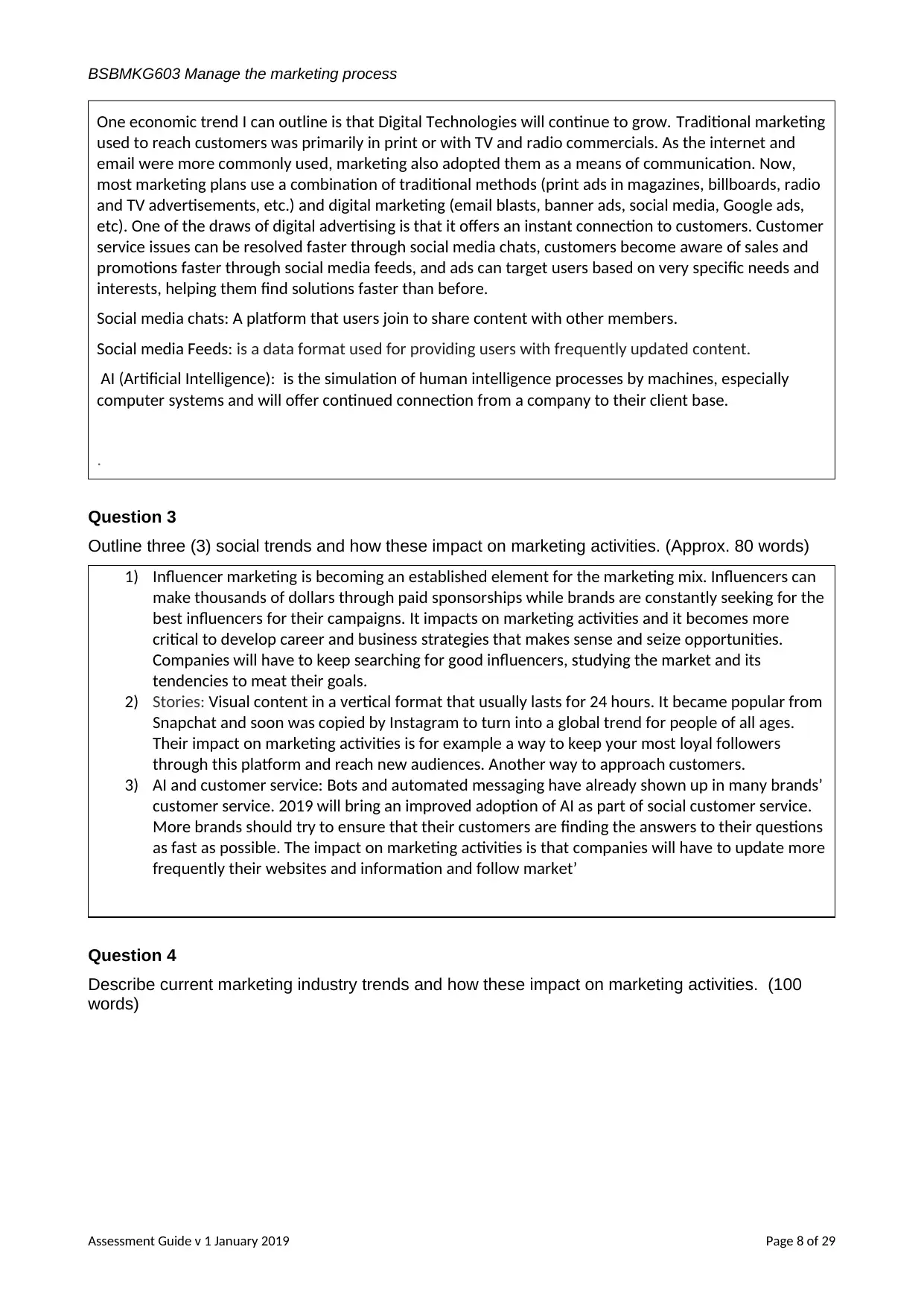
BSBMKG603 Manage the marketing process
One economic trend I can outline is that Digital Technologies will continue to grow. Traditional marketing
used to reach customers was primarily in print or with TV and radio commercials. As the internet and
email were more commonly used, marketing also adopted them as a means of communication. Now,
most marketing plans use a combination of traditional methods (print ads in magazines, billboards, radio
and TV advertisements, etc.) and digital marketing (email blasts, banner ads, social media, Google ads,
etc). One of the draws of digital advertising is that it offers an instant connection to customers. Customer
service issues can be resolved faster through social media chats, customers become aware of sales and
promotions faster through social media feeds, and ads can target users based on very specific needs and
interests, helping them find solutions faster than before.
Social media chats: A platform that users join to share content with other members.
Social media Feeds: is a data format used for providing users with frequently updated content.
AI (Artificial Intelligence): is the simulation of human intelligence processes by machines, especially
computer systems and will offer continued connection from a company to their client base.
.
Question 3
Outline three (3) social trends and how these impact on marketing activities. (Approx. 80 words)
1) Influencer marketing is becoming an established element for the marketing mix. Influencers can
make thousands of dollars through paid sponsorships while brands are constantly seeking for the
best influencers for their campaigns. It impacts on marketing activities and it becomes more
critical to develop career and business strategies that makes sense and seize opportunities.
Companies will have to keep searching for good influencers, studying the market and its
tendencies to meat their goals.
2) Stories: Visual content in a vertical format that usually lasts for 24 hours. It became popular from
Snapchat and soon was copied by Instagram to turn into a global trend for people of all ages.
Their impact on marketing activities is for example a way to keep your most loyal followers
through this platform and reach new audiences. Another way to approach customers.
3) AI and customer service: Bots and automated messaging have already shown up in many brands’
customer service. 2019 will bring an improved adoption of AI as part of social customer service.
More brands should try to ensure that their customers are finding the answers to their questions
as fast as possible. The impact on marketing activities is that companies will have to update more
frequently their websites and information and follow market’
Question 4
Describe current marketing industry trends and how these impact on marketing activities. (100
words)
Assessment Guide v 1 January 2019 Page 8 of 29
One economic trend I can outline is that Digital Technologies will continue to grow. Traditional marketing
used to reach customers was primarily in print or with TV and radio commercials. As the internet and
email were more commonly used, marketing also adopted them as a means of communication. Now,
most marketing plans use a combination of traditional methods (print ads in magazines, billboards, radio
and TV advertisements, etc.) and digital marketing (email blasts, banner ads, social media, Google ads,
etc). One of the draws of digital advertising is that it offers an instant connection to customers. Customer
service issues can be resolved faster through social media chats, customers become aware of sales and
promotions faster through social media feeds, and ads can target users based on very specific needs and
interests, helping them find solutions faster than before.
Social media chats: A platform that users join to share content with other members.
Social media Feeds: is a data format used for providing users with frequently updated content.
AI (Artificial Intelligence): is the simulation of human intelligence processes by machines, especially
computer systems and will offer continued connection from a company to their client base.
.
Question 3
Outline three (3) social trends and how these impact on marketing activities. (Approx. 80 words)
1) Influencer marketing is becoming an established element for the marketing mix. Influencers can
make thousands of dollars through paid sponsorships while brands are constantly seeking for the
best influencers for their campaigns. It impacts on marketing activities and it becomes more
critical to develop career and business strategies that makes sense and seize opportunities.
Companies will have to keep searching for good influencers, studying the market and its
tendencies to meat their goals.
2) Stories: Visual content in a vertical format that usually lasts for 24 hours. It became popular from
Snapchat and soon was copied by Instagram to turn into a global trend for people of all ages.
Their impact on marketing activities is for example a way to keep your most loyal followers
through this platform and reach new audiences. Another way to approach customers.
3) AI and customer service: Bots and automated messaging have already shown up in many brands’
customer service. 2019 will bring an improved adoption of AI as part of social customer service.
More brands should try to ensure that their customers are finding the answers to their questions
as fast as possible. The impact on marketing activities is that companies will have to update more
frequently their websites and information and follow market’
Question 4
Describe current marketing industry trends and how these impact on marketing activities. (100
words)
Assessment Guide v 1 January 2019 Page 8 of 29
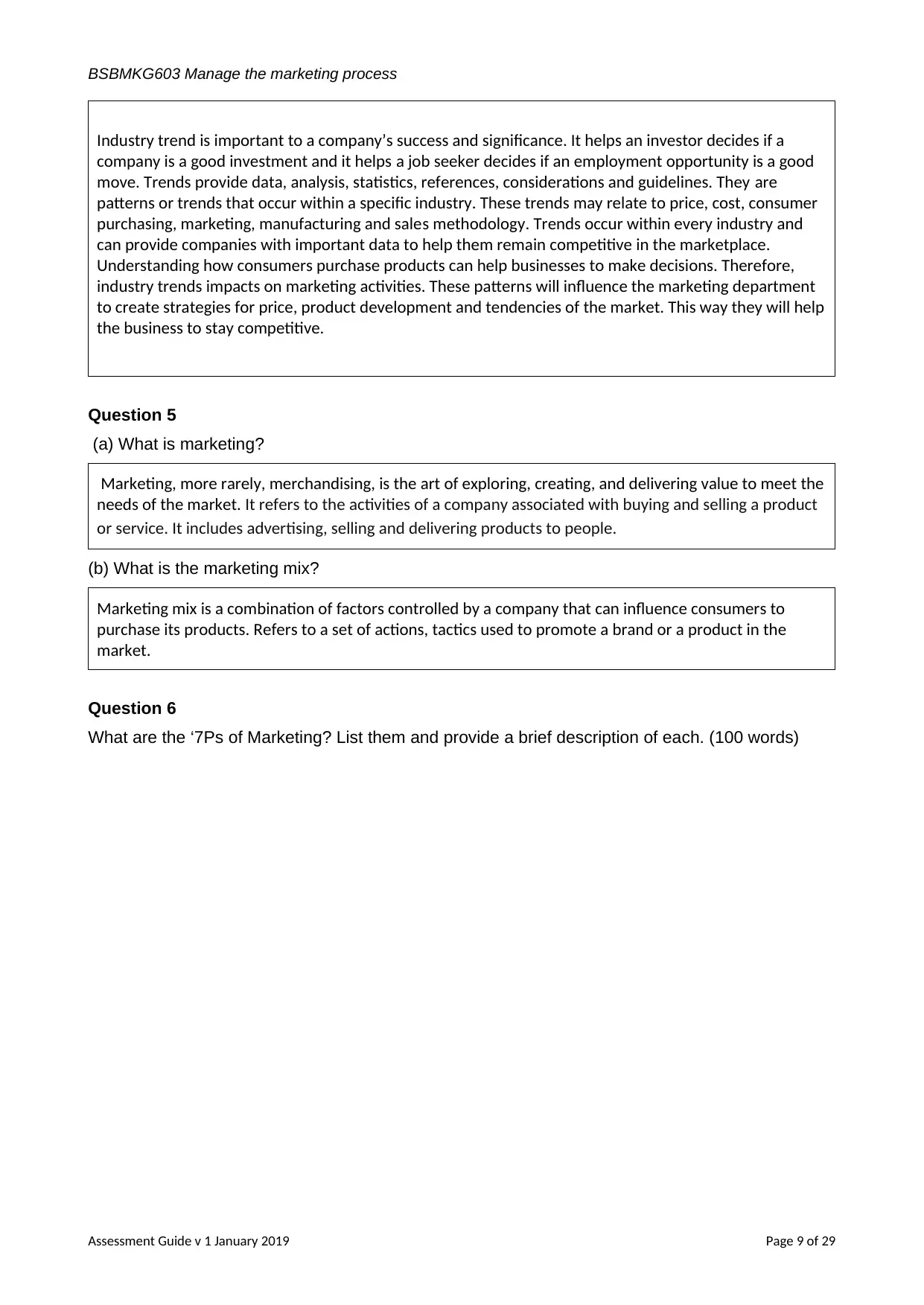
BSBMKG603 Manage the marketing process
Industry trend is important to a company’s success and significance. It helps an investor decides if a
company is a good investment and it helps a job seeker decides if an employment opportunity is a good
move. Trends provide data, analysis, statistics, references, considerations and guidelines. They are
patterns or trends that occur within a specific industry. These trends may relate to price, cost, consumer
purchasing, marketing, manufacturing and sales methodology. Trends occur within every industry and
can provide companies with important data to help them remain competitive in the marketplace.
Understanding how consumers purchase products can help businesses to make decisions. Therefore,
industry trends impacts on marketing activities. These patterns will influence the marketing department
to create strategies for price, product development and tendencies of the market. This way they will help
the business to stay competitive.
Question 5
(a) What is marketing?
Marketing, more rarely, merchandising, is the art of exploring, creating, and delivering value to meet the
needs of the market. It refers to the activities of a company associated with buying and selling a product
or service. It includes advertising, selling and delivering products to people.
(b) What is the marketing mix?
Marketing mix is a combination of factors controlled by a company that can influence consumers to
purchase its products. Refers to a set of actions, tactics used to promote a brand or a product in the
market.
Question 6
What are the ‘7Ps of Marketing? List them and provide a brief description of each. (100 words)
Assessment Guide v 1 January 2019 Page 9 of 29
Industry trend is important to a company’s success and significance. It helps an investor decides if a
company is a good investment and it helps a job seeker decides if an employment opportunity is a good
move. Trends provide data, analysis, statistics, references, considerations and guidelines. They are
patterns or trends that occur within a specific industry. These trends may relate to price, cost, consumer
purchasing, marketing, manufacturing and sales methodology. Trends occur within every industry and
can provide companies with important data to help them remain competitive in the marketplace.
Understanding how consumers purchase products can help businesses to make decisions. Therefore,
industry trends impacts on marketing activities. These patterns will influence the marketing department
to create strategies for price, product development and tendencies of the market. This way they will help
the business to stay competitive.
Question 5
(a) What is marketing?
Marketing, more rarely, merchandising, is the art of exploring, creating, and delivering value to meet the
needs of the market. It refers to the activities of a company associated with buying and selling a product
or service. It includes advertising, selling and delivering products to people.
(b) What is the marketing mix?
Marketing mix is a combination of factors controlled by a company that can influence consumers to
purchase its products. Refers to a set of actions, tactics used to promote a brand or a product in the
market.
Question 6
What are the ‘7Ps of Marketing? List them and provide a brief description of each. (100 words)
Assessment Guide v 1 January 2019 Page 9 of 29
⊘ This is a preview!⊘
Do you want full access?
Subscribe today to unlock all pages.

Trusted by 1+ million students worldwide
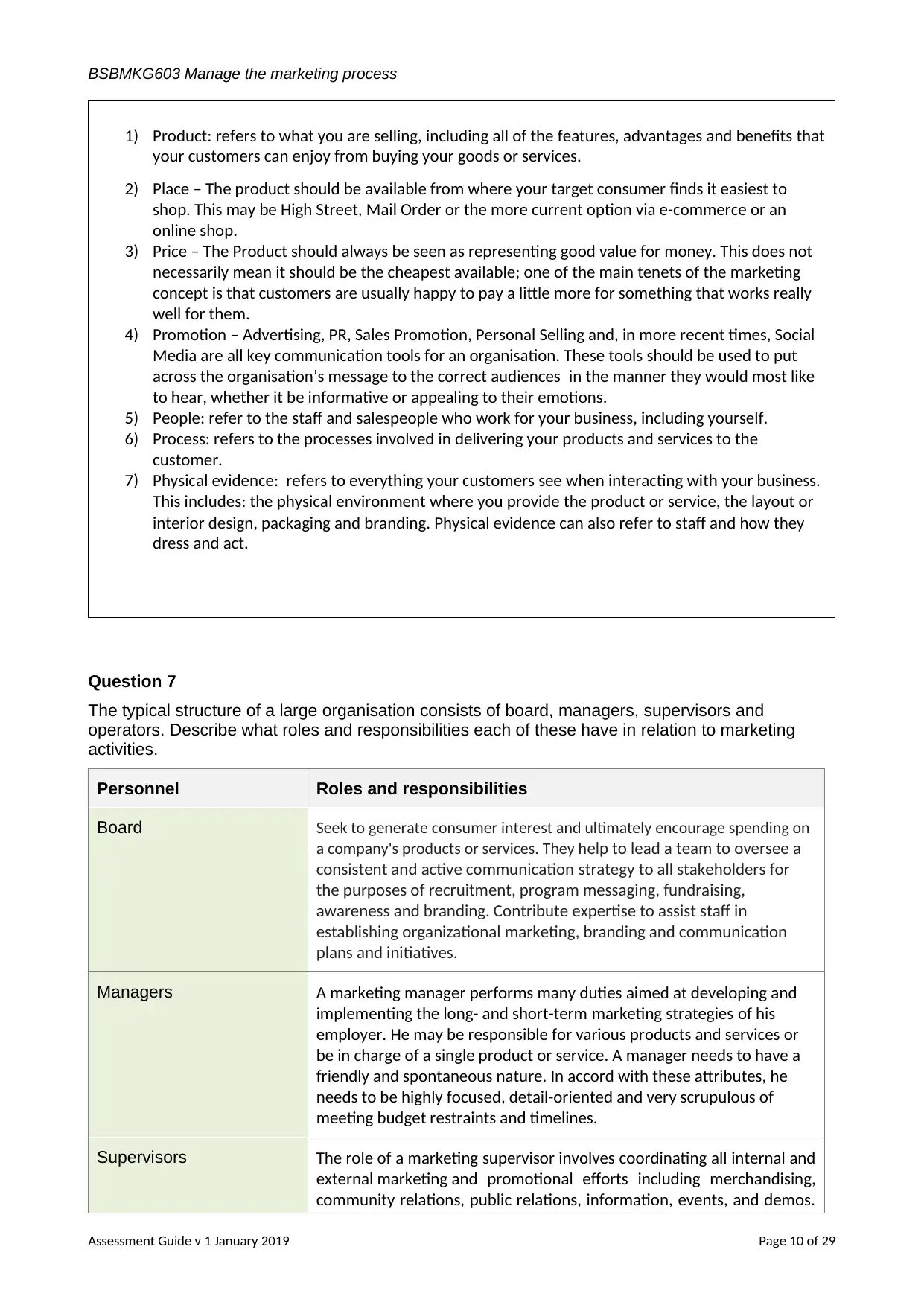
BSBMKG603 Manage the marketing process
1) Product: refers to what you are selling, including all of the features, advantages and benefits that
your customers can enjoy from buying your goods or services.
2) Place – The product should be available from where your target consumer finds it easiest to
shop. This may be High Street, Mail Order or the more current option via e-commerce or an
online shop.
3) Price – The Product should always be seen as representing good value for money. This does not
necessarily mean it should be the cheapest available; one of the main tenets of the marketing
concept is that customers are usually happy to pay a little more for something that works really
well for them.
4) Promotion – Advertising, PR, Sales Promotion, Personal Selling and, in more recent times, Social
Media are all key communication tools for an organisation. These tools should be used to put
across the organisation’s message to the correct audiences in the manner they would most like
to hear, whether it be informative or appealing to their emotions.
5) People: refer to the staff and salespeople who work for your business, including yourself.
6) Process: refers to the processes involved in delivering your products and services to the
customer.
7) Physical evidence: refers to everything your customers see when interacting with your business.
This includes: the physical environment where you provide the product or service, the layout or
interior design, packaging and branding. Physical evidence can also refer to staff and how they
dress and act.
Question 7
The typical structure of a large organisation consists of board, managers, supervisors and
operators. Describe what roles and responsibilities each of these have in relation to marketing
activities.
Personnel Roles and responsibilities
Board Seek to generate consumer interest and ultimately encourage spending on
a company's products or services. They help to lead a team to oversee a
consistent and active communication strategy to all stakeholders for
the purposes of recruitment, program messaging, fundraising,
awareness and branding. Contribute expertise to assist staff in
establishing organizational marketing, branding and communication
plans and initiatives.
Managers A marketing manager performs many duties aimed at developing and
implementing the long- and short-term marketing strategies of his
employer. He may be responsible for various products and services or
be in charge of a single product or service. A manager needs to have a
friendly and spontaneous nature. In accord with these attributes, he
needs to be highly focused, detail-oriented and very scrupulous of
meeting budget restraints and timelines.
Supervisors The role of a marketing supervisor involves coordinating all internal and
external marketing and promotional efforts including merchandising,
community relations, public relations, information, events, and demos.
Assessment Guide v 1 January 2019 Page 10 of 29
1) Product: refers to what you are selling, including all of the features, advantages and benefits that
your customers can enjoy from buying your goods or services.
2) Place – The product should be available from where your target consumer finds it easiest to
shop. This may be High Street, Mail Order or the more current option via e-commerce or an
online shop.
3) Price – The Product should always be seen as representing good value for money. This does not
necessarily mean it should be the cheapest available; one of the main tenets of the marketing
concept is that customers are usually happy to pay a little more for something that works really
well for them.
4) Promotion – Advertising, PR, Sales Promotion, Personal Selling and, in more recent times, Social
Media are all key communication tools for an organisation. These tools should be used to put
across the organisation’s message to the correct audiences in the manner they would most like
to hear, whether it be informative or appealing to their emotions.
5) People: refer to the staff and salespeople who work for your business, including yourself.
6) Process: refers to the processes involved in delivering your products and services to the
customer.
7) Physical evidence: refers to everything your customers see when interacting with your business.
This includes: the physical environment where you provide the product or service, the layout or
interior design, packaging and branding. Physical evidence can also refer to staff and how they
dress and act.
Question 7
The typical structure of a large organisation consists of board, managers, supervisors and
operators. Describe what roles and responsibilities each of these have in relation to marketing
activities.
Personnel Roles and responsibilities
Board Seek to generate consumer interest and ultimately encourage spending on
a company's products or services. They help to lead a team to oversee a
consistent and active communication strategy to all stakeholders for
the purposes of recruitment, program messaging, fundraising,
awareness and branding. Contribute expertise to assist staff in
establishing organizational marketing, branding and communication
plans and initiatives.
Managers A marketing manager performs many duties aimed at developing and
implementing the long- and short-term marketing strategies of his
employer. He may be responsible for various products and services or
be in charge of a single product or service. A manager needs to have a
friendly and spontaneous nature. In accord with these attributes, he
needs to be highly focused, detail-oriented and very scrupulous of
meeting budget restraints and timelines.
Supervisors The role of a marketing supervisor involves coordinating all internal and
external marketing and promotional efforts including merchandising,
community relations, public relations, information, events, and demos.
Assessment Guide v 1 January 2019 Page 10 of 29
Paraphrase This Document
Need a fresh take? Get an instant paraphrase of this document with our AI Paraphraser
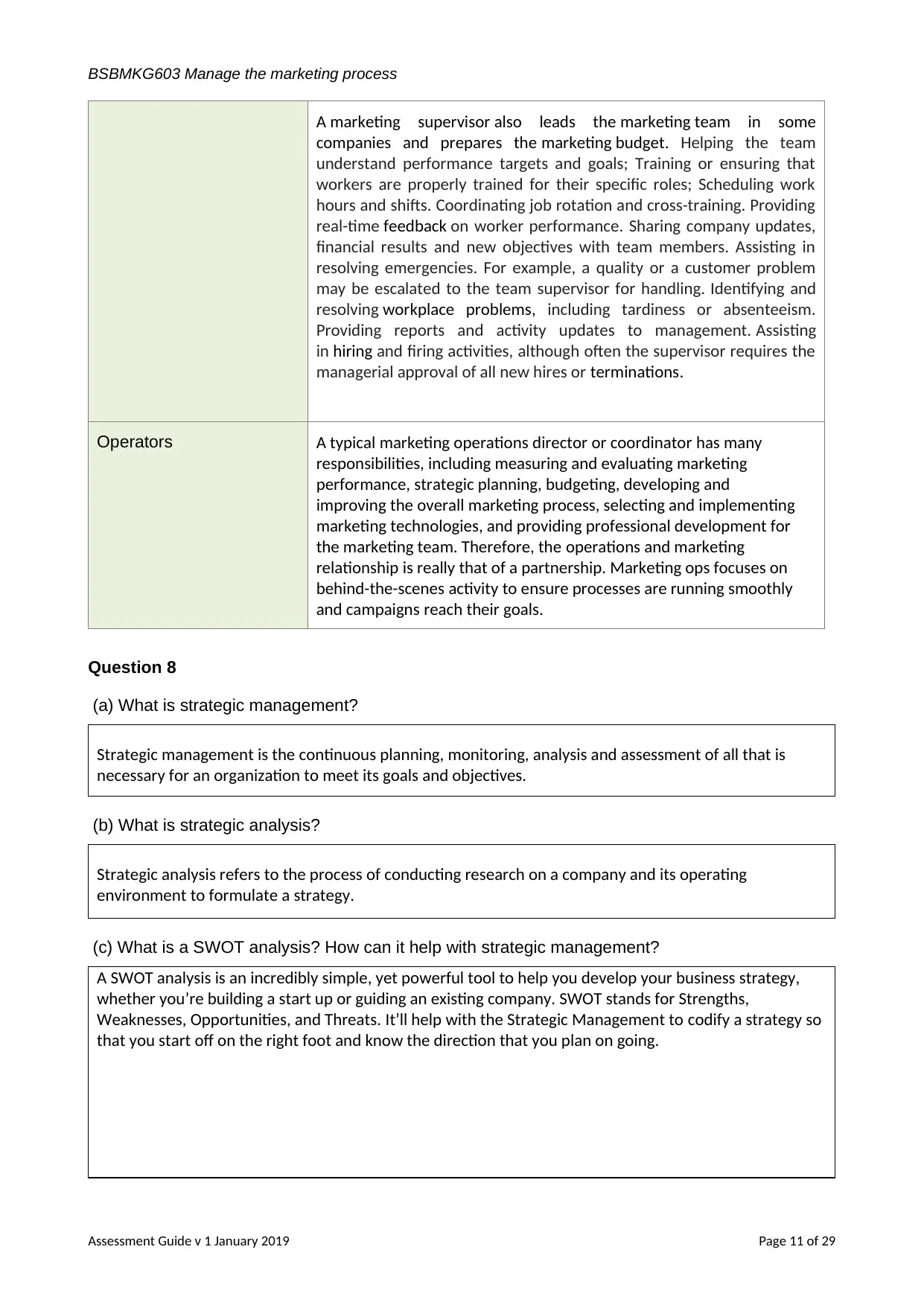
BSBMKG603 Manage the marketing process
A marketing supervisor also leads the marketing team in some
companies and prepares the marketing budget. Helping the team
understand performance targets and goals; Training or ensuring that
workers are properly trained for their specific roles; Scheduling work
hours and shifts. Coordinating job rotation and cross-training. Providing
real-time feedback on worker performance. Sharing company updates,
financial results and new objectives with team members. Assisting in
resolving emergencies. For example, a quality or a customer problem
may be escalated to the team supervisor for handling. Identifying and
resolving workplace problems, including tardiness or absenteeism.
Providing reports and activity updates to management. Assisting
in hiring and firing activities, although often the supervisor requires the
managerial approval of all new hires or terminations.
Operators A typical marketing operations director or coordinator has many
responsibilities, including measuring and evaluating marketing
performance, strategic planning, budgeting, developing and
improving the overall marketing process, selecting and implementing
marketing technologies, and providing professional development for
the marketing team. Therefore, the operations and marketing
relationship is really that of a partnership. Marketing ops focuses on
behind-the-scenes activity to ensure processes are running smoothly
and campaigns reach their goals.
Question 8
(a) What is strategic management?
Strategic management is the continuous planning, monitoring, analysis and assessment of all that is
necessary for an organization to meet its goals and objectives.
(b) What is strategic analysis?
Strategic analysis refers to the process of conducting research on a company and its operating
environment to formulate a strategy.
(c) What is a SWOT analysis? How can it help with strategic management?
A SWOT analysis is an incredibly simple, yet powerful tool to help you develop your business strategy,
whether you’re building a start up or guiding an existing company. SWOT stands for Strengths,
Weaknesses, Opportunities, and Threats. It’ll help with the Strategic Management to codify a strategy so
that you start off on the right foot and know the direction that you plan on going.
Assessment Guide v 1 January 2019 Page 11 of 29
A marketing supervisor also leads the marketing team in some
companies and prepares the marketing budget. Helping the team
understand performance targets and goals; Training or ensuring that
workers are properly trained for their specific roles; Scheduling work
hours and shifts. Coordinating job rotation and cross-training. Providing
real-time feedback on worker performance. Sharing company updates,
financial results and new objectives with team members. Assisting in
resolving emergencies. For example, a quality or a customer problem
may be escalated to the team supervisor for handling. Identifying and
resolving workplace problems, including tardiness or absenteeism.
Providing reports and activity updates to management. Assisting
in hiring and firing activities, although often the supervisor requires the
managerial approval of all new hires or terminations.
Operators A typical marketing operations director or coordinator has many
responsibilities, including measuring and evaluating marketing
performance, strategic planning, budgeting, developing and
improving the overall marketing process, selecting and implementing
marketing technologies, and providing professional development for
the marketing team. Therefore, the operations and marketing
relationship is really that of a partnership. Marketing ops focuses on
behind-the-scenes activity to ensure processes are running smoothly
and campaigns reach their goals.
Question 8
(a) What is strategic management?
Strategic management is the continuous planning, monitoring, analysis and assessment of all that is
necessary for an organization to meet its goals and objectives.
(b) What is strategic analysis?
Strategic analysis refers to the process of conducting research on a company and its operating
environment to formulate a strategy.
(c) What is a SWOT analysis? How can it help with strategic management?
A SWOT analysis is an incredibly simple, yet powerful tool to help you develop your business strategy,
whether you’re building a start up or guiding an existing company. SWOT stands for Strengths,
Weaknesses, Opportunities, and Threats. It’ll help with the Strategic Management to codify a strategy so
that you start off on the right foot and know the direction that you plan on going.
Assessment Guide v 1 January 2019 Page 11 of 29
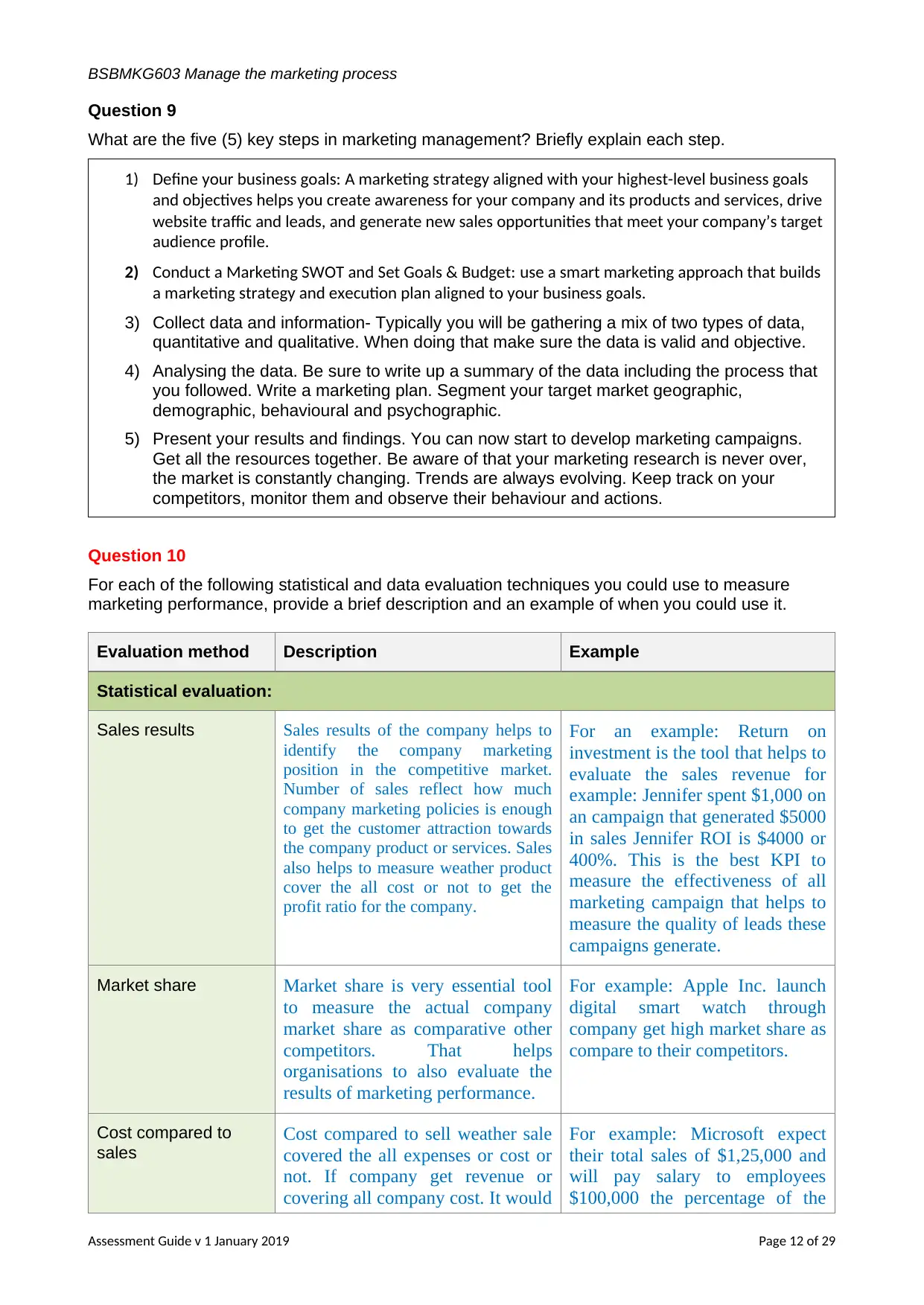
BSBMKG603 Manage the marketing process
Question 9
What are the five (5) key steps in marketing management? Briefly explain each step.
1) Define your business goals: A marketing strategy aligned with your highest-level business goals
and objectives helps you create awareness for your company and its products and services, drive
website traffic and leads, and generate new sales opportunities that meet your company’s target
audience profile.
2) Conduct a Marketing SWOT and Set Goals & Budget: use a smart marketing approach that builds
a marketing strategy and execution plan aligned to your business goals.
3) Collect data and information- Typically you will be gathering a mix of two types of data,
quantitative and qualitative. When doing that make sure the data is valid and objective.
4) Analysing the data. Be sure to write up a summary of the data including the process that
you followed. Write a marketing plan. Segment your target market geographic,
demographic, behavioural and psychographic.
5) Present your results and findings. You can now start to develop marketing campaigns.
Get all the resources together. Be aware of that your marketing research is never over,
the market is constantly changing. Trends are always evolving. Keep track on your
competitors, monitor them and observe their behaviour and actions.
Question 10
For each of the following statistical and data evaluation techniques you could use to measure
marketing performance, provide a brief description and an example of when you could use it.
Evaluation method Description Example
Statistical evaluation:
Sales results Sales results of the company helps to
identify the company marketing
position in the competitive market.
Number of sales reflect how much
company marketing policies is enough
to get the customer attraction towards
the company product or services. Sales
also helps to measure weather product
cover the all cost or not to get the
profit ratio for the company.
For an example: Return on
investment is the tool that helps to
evaluate the sales revenue for
example: Jennifer spent $1,000 on
an campaign that generated $5000
in sales Jennifer ROI is $4000 or
400%. This is the best KPI to
measure the effectiveness of all
marketing campaign that helps to
measure the quality of leads these
campaigns generate.
Market share Market share is very essential tool
to measure the actual company
market share as comparative other
competitors. That helps
organisations to also evaluate the
results of marketing performance.
For example: Apple Inc. launch
digital smart watch through
company get high market share as
compare to their competitors.
Cost compared to
sales
Cost compared to sell weather sale
covered the all expenses or cost or
not. If company get revenue or
covering all company cost. It would
For example: Microsoft expect
their total sales of $1,25,000 and
will pay salary to employees
$100,000 the percentage of the
Assessment Guide v 1 January 2019 Page 12 of 29
Question 9
What are the five (5) key steps in marketing management? Briefly explain each step.
1) Define your business goals: A marketing strategy aligned with your highest-level business goals
and objectives helps you create awareness for your company and its products and services, drive
website traffic and leads, and generate new sales opportunities that meet your company’s target
audience profile.
2) Conduct a Marketing SWOT and Set Goals & Budget: use a smart marketing approach that builds
a marketing strategy and execution plan aligned to your business goals.
3) Collect data and information- Typically you will be gathering a mix of two types of data,
quantitative and qualitative. When doing that make sure the data is valid and objective.
4) Analysing the data. Be sure to write up a summary of the data including the process that
you followed. Write a marketing plan. Segment your target market geographic,
demographic, behavioural and psychographic.
5) Present your results and findings. You can now start to develop marketing campaigns.
Get all the resources together. Be aware of that your marketing research is never over,
the market is constantly changing. Trends are always evolving. Keep track on your
competitors, monitor them and observe their behaviour and actions.
Question 10
For each of the following statistical and data evaluation techniques you could use to measure
marketing performance, provide a brief description and an example of when you could use it.
Evaluation method Description Example
Statistical evaluation:
Sales results Sales results of the company helps to
identify the company marketing
position in the competitive market.
Number of sales reflect how much
company marketing policies is enough
to get the customer attraction towards
the company product or services. Sales
also helps to measure weather product
cover the all cost or not to get the
profit ratio for the company.
For an example: Return on
investment is the tool that helps to
evaluate the sales revenue for
example: Jennifer spent $1,000 on
an campaign that generated $5000
in sales Jennifer ROI is $4000 or
400%. This is the best KPI to
measure the effectiveness of all
marketing campaign that helps to
measure the quality of leads these
campaigns generate.
Market share Market share is very essential tool
to measure the actual company
market share as comparative other
competitors. That helps
organisations to also evaluate the
results of marketing performance.
For example: Apple Inc. launch
digital smart watch through
company get high market share as
compare to their competitors.
Cost compared to
sales
Cost compared to sell weather sale
covered the all expenses or cost or
not. If company get revenue or
covering all company cost. It would
For example: Microsoft expect
their total sales of $1,25,000 and
will pay salary to employees
$100,000 the percentage of the
Assessment Guide v 1 January 2019 Page 12 of 29
⊘ This is a preview!⊘
Do you want full access?
Subscribe today to unlock all pages.

Trusted by 1+ million students worldwide
1 out of 28
Related Documents
Your All-in-One AI-Powered Toolkit for Academic Success.
+13062052269
info@desklib.com
Available 24*7 on WhatsApp / Email
![[object Object]](/_next/static/media/star-bottom.7253800d.svg)
Unlock your academic potential
Copyright © 2020–2025 A2Z Services. All Rights Reserved. Developed and managed by ZUCOL.




